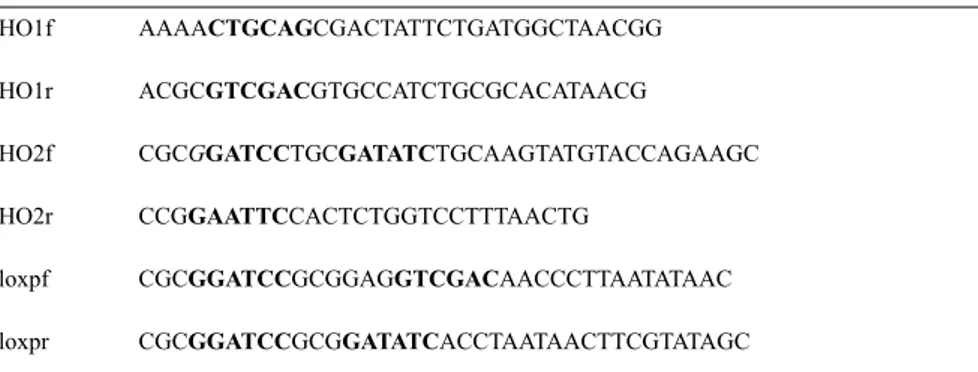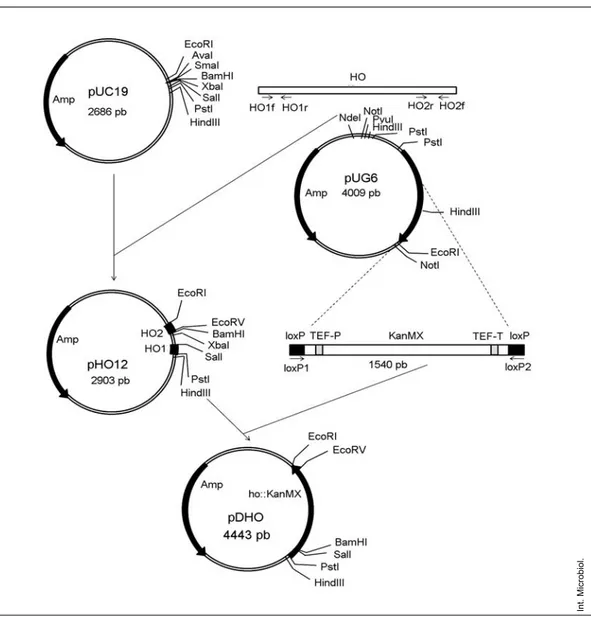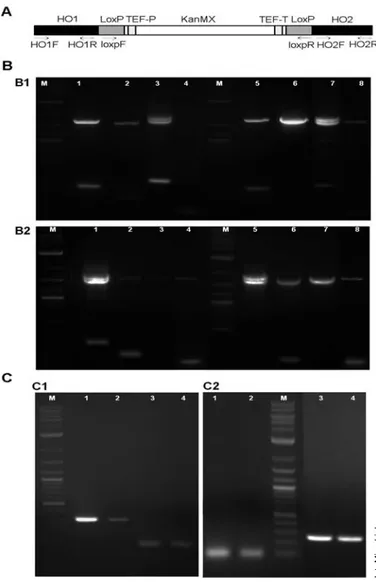Summary. Yeasts are responsible for several traits in fermented beverages, including wine and beer, and their genetic
manipulation is often necessary to improve the quality of the fermentation product. Improvement of wild-type strains of
Saccharomyces cerevisiae and Saccharomyces pastorianus is difficult due to their homothallic character and variable ploidy
level. Homothallism is determined by the HO gene in S. cerevisiae and the Sc-HO gene in S. pastorianus. In this work, we
describe the construction of an HO disruption vector (pDHO) containing an HO disruption cassette and discuss its use in
gen-erating heterothallic yeast strains from homothallic Saccharomyces species. [Int Microbiol 2011; 14(4):201-206]
Keywords: Saccharomyces cerevisiae · Saccharomyces pastorianus · homothallic · heterothallic · gene deletion
Introduction
The manipulation of yeast by humans dates back some 7000
years, when beer and wine were first produced [6].
Nowadays, most of the yeast varieties used in industry derive
from wild-type strains, although they have been selected over
long periods of time in order to improve the final products
[1,9,15]. Formerly, mixtures of several species were used in
fermentations whereas today industrial fermentations are
per-formed by the addition of ‘starter cultures’ in order to obtain
homogeneous final products. As a general rule, the yeast
Saccharomyces cerevisiae serves as the starter culture in the
production of wine and beer, mostly based on its ethanol
tol-erance. Another species, Saccharomyces pastorianus, is used
to produce lager beer because of its ability to ferment at low
temperatures [2,4,7,9]. Both S. cerevisiae and S. pastorianus
are Saccharomyces sensu stricto species, i.e., they belong to
the genus Saccharomyces and are so closely related that, in
some cases, they can hybridize and produce viable fertile
progeny [11]. Wild-type strains of these species are generally
diploid or polyploid, homothallic, heterozygous, poorly
sporulating cells, and they are often genetically unstable. The
above-mentioned characteristics make it difficult to perform
genetic manipulations, which are necessary to obtain a final
I
NTERNATIONALM
ICROBIOLOGY(2011) 14:201-206
DOI: 10.2436/20.1501.01.149 ISSN: 1139-6709 www.im.microbios.org
*Corresponding author: T.G. Villa
Department of Microbiology, Faculty of Pharmacy University of Santiago de Compostela
15782 Santiago de Compostela, Spain Tel +34-981592490. Fax +34-981594912 E-mail: [email protected]
Lucía Blasco,
1Patricia Veiga-Crespo,
3Miquel Viñas,
4Tomás G. Villa
1,2*
1
Department of Microbiology,
2School of Biotechnology, Faculty of Pharmacy, University of Santiago de Compostela, Spain.
3
Departament of Cellular Biology and Histology, Faculty of Medicine, University of the Basque Country, Biscay, Spain.
4Departament of Pathology and Experimental Therapeutics, Medical School, University of Barcelona,
IDIBELL, L’Hospitalet, Barcelona, Spain
Received 8 September 2011 · Accepted 30 October 2011
A new disruption vector (pDHO) to obtain
heterothallic strains from both Saccharomyces
product, such as wine or beer, with homogeneous properties
[1,2,9,10,13,14].
Genetic improvement of wild-type S. cerevisiae strains is
difficult because of their homothallism trait and their ploidy
level. When a homothallic haploid is generated by meiosis, it
quickly switches its “a” or “
α” types, subsequently mating
and generating a diploid identical to the parental cell. The
HO gene, responsible for homothallism, codes for a
site-spe-cific endonuclease that recognizes the mating-type locus and
produces a double-stranded break. Hence, DNA repair results
in a switch in the MAT locus affecting the “a” or “
α”
cas-settes. Heterothallic strains contain a defective HO gene that
prevents MAT locus switching. These strains can be
improved by sexual breeding because, after meiosis, they
remain in the haploid state and can be mated with the
desir-able strain [5,17,19]. Homothallism is present in several
industrially relevant species of Saccharomyces sensu stricto,
such as S. cerevisiae and S. pastorianus [11]. S. pastorianus,
a natural hybrid of S. cerevisiae and Saccharomyces bayanus,
carries two types of chromosomes, one from S. cerevisiae
and the other from S. bayanus, and therefore has two HO
gene types [4,16,20]. The Sc-HO gene (S. cerevisiae type
HO) derives from S. cerevisiae, whereas the Lg-HO gene
(lager-fermenting yeast-specific HO) comes from S.
ba-yanus. The two HO genes are functional and located in their
respective chromosomal type [18]. Although both types
pro-vide the homothallic character, deletion of the Lg-HO gene
renders the yeast heterothallic, despite the remaining Sc-HO
gene [8,18].
Here we describe the design of a vector with a disruption
cassette for the HO gene (based on the S. cerevisiae gene)
that renders S. cerevisiae and S. pastorianus more amenable
to genetic manipulation and improvement. This cassette
worked well on both S. cerevisiae and S. pastorianus, as we
succeeded in obtaining heterothallic, competent mating
strains for both yeast species.
Materials and methods
Strains and media. Wine wild-type strain 145A211 and two genetic
strains, CSH84 L(α) and CSH89L(a), from S. cerevisiae, and the brewery strain Weihenstephan 34/70 from S. pastorianus were used. Escherichia coli TOP10 (Invitrogen) was grown in Luria Bertani (LB) (tryptone 1 %, yeast extract 0.5 %, CaCl 1 %) medium at 37 ºC. S. cerevisiae and S. pastorianus were grown in YPD (dextrose 2 %, yeast extract 1 %, peptone 2 %). Yeast strains harboring auxotrophies were grown in selective dropout (SD) (yeast extract without amino acids 0.67 %, glucose 2 %) medium supplemented with the required amino acid(s). When another carbon source was used for galactose incorporation, YPD and SD were substituted by YPGal and SGal, respectively. All yeast cultures were maintained at 30 ºC. When cultured in sporulation medium SPOI (potassium acetate 1 %, yeast extract 0.1 %, glu-cose 0.05 %), the strains were maintained at 23 ºC for 5 days. Solid media were prepared by the addition of 2 % agar. When necessary, the media were supplemented with G418 (200 μg/ml; Sigma-Aldrich).
Nucleic acid manipulations. Genomic DNA was isolated from an
overnight yeast culture using the Genomic Purification Kit (Promega). Enzymatic digestion was done using restriction enzymes from Takara. PCRs were carried out with the primers listed in Table 1. DNA was amplified using the proofreading polymerase ACCUZYMETMDNA polymerase (Bioline). In
PCRs, to verify correct integration and deletion of the cassette, the BIO-TAQTMDNA polymerase (Bioline) was used (Table 1).
pDHO vector construction. Plasmid pDHO (plasmid for HO
disrup-tion) was designed to direct loxp-KanMX-loxP cassette integration into the
HO gene by homologous recombination (Fig. 1). Two fragments of the HO
gene were obtained by PCR amplification of yeast genomic DNA. Primers HO1f and HO1r yielded an 80-bp DNA fragment (HO1) corresponding to nucleotides 16–96 of the HO gene, flanked by PstI (5´) and SalI (3´) restric-tion sites, which were included in the primers. Primers HO2f and HO2r gave an amplicon of 137 bp (HO2), corresponding to nucleotides 1572–1654 of the HO gene, flanked by BamHI and EcoRV (5´) and EcoRI (3´) restriction sites. The G418 resistance cassette loxP-KanMX-loxP was PCR-amplified from plasmid pUG6, using the loxpF and loxpR primers, which contained
BamHI and SalI, and BamHI and EcoRV restriction sites, respectively. The
Table 1. List of primers
HO1f AAAACTGCAGCGACTATTCTGATGGCTAACGG HO1r ACGCGTCGACGTGCCATCTGCGCACATAACG HO2f CGCGGATCCTGCGATATCTGCAAGTATGTACCAGAAGC HO2r CCGGAATTCCACTCTGGTCCTTTAACTG loxpf CGCGGATCCGCGGAGGTCGACAACCCTTAATATAAC loxpr CGCGGATCCGCGGATATCACCTAATAACTTCGTATAGC
HO1 and HO2 fragments were then digested with PstI and EcoRI, respec-tively, and inserted into pUC19, thus generating the pHO12 plasmid. This plasmid was subsequently digested with BamHI and EcoRV. The loxP-KanMX-loxP disruption cassette was digested with the same enzymes fol-lowed by ligation into pHO12, between HO1 and HO2, thus generating plas-mid pDHO.
Yeast transformation. Yeast transformations were performed with
lithium acetate, using either 2 μg of plasmid DNA or 3–5 μg of PCR prod-uct. Selection was in YPD supplemented with the appropriate antibiotic or in SD media lacking the corresponding amino acid.
Resistance cassette elimination. The vector used in these
experi-ments was YEp351-Cre-Cyh, which contains a galactose-inducible cre-loxP system, as describe by Delneri et al. [3].
Tetrad analysis. Tetrads were obtained from either homothallic diploid
strains or heterothallic diploids generated by mating the appropriate strains. The diploids were maintained in SPOI medium for 7 days at 30 ºC, until an
appropriate number of asci containing four ascospores were available. Asci were collected and treated with 0.5 μg/ml lyticase (Sigma-Aldrich) at 30 ºC for 15 min. Lyticase-treated asci were dissected using a Micromanipulator II (Allen Benjamin Inc.) coupled to a Nikon SE microscope.
Results and Discussion
The pDHO vector. Yeast genetic manipulation can be
carried out by clonal selection, mutation, hybridization,
cloning, and transformation. The combination of all of these
techniques has increased the possibilities to artificially
intro-duce diversity in yeasts [9]. Yeast genes can be deleted or
dis-rupted by homologous recombination between a disrupting
cassette and the genomic DNA. In such cases, the gene is
Fig. 1. pDHO vector construction.
replaced by the cassette, which usually consists of a
resist-ance or prototrophic marker gene flanked by two regions
cor-responding to the right and left extremes of the disrupted
gene [12,22]. Here we report the construction of a vector
(pDHO) containing a disrupting cassette (Fig. 1) that causes
the specific deletion of the HO (Genbank X90957.1) and
Sc-HO genes (Genbank AB027449.1) present in S. cerevisiae
and S. pastorianus, respectively.
Amplification of HO1 and HO2 fragments and their
sub-sequent cloning into pUC19 resulted in a new plasmid,
pHO12. Amplification of the cassette loxP-KanMX-loxP
from the pUG6 plasmid and its cloning into pHO12 between
HO1 and HO2 gave rise to the disruption vector pDHO,
con-taining the HO-KanMX disruption cassette, which disrupts
the homothallism in HO from S. cerevisiae and Sc-HO from
S. pastorianus, which can be obtained from the pDHO vector
by PCR or by enzyme digestion.
Generation of heterothallic strains. We used the
HO-KanMX disruption cassette, obtained by PCR using the
primers HO1F/HO2R, to transform S. cerevisiae wine strain
145A211 and S. pastorianus Weihestephan 34/70 lager strain.
This resulted in 100 S. cerevisiae transformants/
μg DNA and
about 40 S. pastorianus transformants/
μg DNA. Two
G418-resistant transformants containing the HO-KanMX cassette
were selected for each strain. Disruption of the HO and Sc-HO
genes and the correct insertion of the cassette were confirmed
by PCR, using the primers pairs sets described in Table 1.
Amplification of the expected size PCR fragments was
obtained, as seen in Fig. 2A, B. Primers HO1F/HO2R
generat-ed, in all cases, two PCR fragments: one of 1761 bp,
sponding to the wild-type gene, and another of 1879 bp,
corre-sponding to the gene disrupted with the cassette. The presence
of two bands indicated that only one allele was disrupted and
therefore that the G418-resistant clones were heterozygous for
Fig. 2. PCR analyses of the yeast clones generated to confirm correct
cassette integration and gene deletions. (A) Schematic representation of the HO-KanMX cassette, with the location of the different PCR primers used for the analyses indicated. (B) Correct integration of the cassette into the yeast DNA was verified by PCR amplification using different combinations of primers. (B1) S. cerevisiae 145A211 clone1 (lanes 1–4) and clone 2 (lanes 5–8), were amplified with primers HO1f/HO2r (lanes 3 and 7); HO1f, loxpr (lanes 1 and 5); loxpf/HO2r (lanes 2 and 6); and loxpf/lopr (lanes 4 and 8). (B2) S. pastorianus Weihenstephan 34/70 clone1 (lanes 1–4) and clone 2 (lanes 5-8) were amplified with primers: HO1f/HO2r (lanes 1 and 5); HO1f/loxpr (lanes 2 and 6); loxpf/HO2r (lanes 3 and 7); and loxpf/loxpr (lanes 4 and 8). (C) PCR-amplified chromosomal DNA from two of the Δho clones generated from S. cerevisiae 145A211 and S. pastorianus Weihenstephan 34/70, to confirm removal of the HO and sc-HO genes, respectively. PCR amplification was carried for: (C1) S.
cere-visiae 145A211 clone1 (lanes 1 and 3) and clone 2 (lanes 2 and 4) with
primers: HO1f/HO2r (lanes 1 and 2) and loxpf/loxpr (lanes 3 and 4). (C2) S. pastorianus Weihenstephan 34/70. Clone1 (lanes 1 and 3) and clone 2 (lanes 2 and 4) were amplified with primers: HO1f/HO2r (lanes 3 and 4) and loxpf/loxpr (lanes 1 and 2). Lane M corresponds to the molecular weight marker 2-Log DNA Ladder (GE Healthcare).
sc-HO and HO (sc-HO/Sc-ho::KanMX and HO/ho::KanMX),
since recombination of the disruption cassette occurred only in
one chromosome of the pair [3].
To obtain a homozygous disrupted strain, the
sc-HO/Sc-ho::KanMX and HO/sc-HO/Sc-ho::KanMX transformants were
induced to sporulate in SPOI medium, followed by the
selec-tion of G418-resistant spore clones. As gene segregaselec-tion was
2:2, half of the spores were resistant to G418 and therefore
ho::KanMX and Sc-ho::KanMX. These resistant spore
clones were cultured in sporulation medium but no asci were
obtained, confirming the heterothallic nature of the S.
cere-visiae and S. pastorianus strains generated.
As genetically engineered yeast strains harboring
exoge-nous DNA are not permitted in industrial use, the resistance
KanMX cassette was removed. For this purpose, we selected
a disrupted ho::KanMX clone from S. cerevisiae and another
from S. pastorianus and transformed them with the vector
YEp351-Cre-Cyh. The transformants obtained (
Δho), lacking
the exogenous KanMX gene, were selected based on their
inability to grow in the presence of G418. To confirm the
removal of the exogenous cassette, the resulting constructs
were PCR-amplified. As seen in Fig. 2C, amplification with
the HO1/HO2 primer pair produced only a DNA fragment of
the expected size (HO1 plus the HO2 fragments).
Additionally, no PCR product was obtained when primers
loxpf/loxpr were employed, confirming elimination of the
Kan resistance cassette.
Mating ability of the heterothallic strains
gen-erated. To verify the mating competence of the
heterothal-lic cells generated above, we mated six spore clones each for
S. cerevisiae and S. pastorianus with two S. cerevisiae
strains, CSH84L(
α) and CSH89L(a). In all mating assays,
diploid cells were obtained with only one of the mating type
strains (either
α or a), thus establishing the mating type of the
generated S. cerevisiae and S. pastorianus spores. Like the
strains derived from 145A211 and Weihestephan 34/70, they
lacked auxotrophic markers. The presence of zygotes and the
sporulation ability of the cells obtained confirmed the
occur-rence of mating and therefore the heterothallism of the
Δho
strains in both species. Although S. pastorianus contains two
HO gene types, Sc-HO and Lg-HO, heterothallic competent
mating strains could be obtained simply by deletion of the
Sc-HO gene. The pDHO vector described herein is thus a
useful tool for obtaining heterothallic strains from both S.
ce-revisiae and S. pastorianus. These heterothallic strains can,
in turn, be used to improve industrial strains by either
tradi-tional breeding techniques or genetic engineering.
Acknowledgements. The authors wish to express their gratitude to the
School of Biotechnology of the University of Santiago de Compostela and the Ramón Areces Foundation for partly furnishing the laboratory where this work was done. They also thank A.S.P. from Sydney University, Australia, for useful comments on the manuscript.
Competing interests: None declared.
References
1. Blasco L, Feijoo-Siota L, Veiga-Crespo P, Villa TG (2008) Genetic sta-bilization of Saccharomyces cerevisiae oenological strains by using benomyl. Int Microbiol 11:127-132
2. Cebollero E, González-Ramos D, Tabera L, González R (2007) Transgenic wine yeast technology comes of age: is it time for transgenic wine? Biotechnol Lett 29:191-200
3. Delneri D, Tomlin GC, Wixon JL, Huter A, Sefton M, Louis EJ, Oliver SG (2000) Exploring redundancy in yeast genome: An improving strat-egy for use of the cre-loxP system. Gene 252:127-135
4. Dunn B, Sherlock G (2008) Reconstruction of the genome origins and evolution of the hybrid lager yeast Saccharomyces pastorianus. Genome Res 18:1610-1623
5. Herskowitz I, Jensen RE (1991) Putting HO gene to work: practical uses for mating-type switching. In: Guthrie C, Fink GR (eds) Methods in Enzymology. Guide to yeast genetics and molecular biology. Academic Press, San Diego, USA, pp 132-146
6. García Garibay M, López-Mungía Canales A (2004) Non distilled alco-holic beverages. In: García Garibay MR, Quintero Ramírez A & López-Mungía Canales A (eds) Food Biotecnology (In Spanish). Editorial Limusa, México D.F., México, pp 263-317
7. Moreno-Arribas M, Polo MC (2005) Winemaking biochemistry and microbiology: current knowledge and future trends. Crit Rev Food Sci Nutr 45:265-268
8. NakaoY, Kanamori T, Itoh T, et al. (2009) Genome sequence of the lager brewing yeast, an interspecies hybrid. DNA Res 16:115-129
9. Pretorius IS (2000) Tailoring wine yeast for the new millennium: novel approaches to the ancient wine making. Yeast 16:675-729
10. Puig S, Querol A, Barrio E, Pérez-Ortín JE (2000) Mitotic recombina-tion and genetic changes in Saccharomyces cerevisiae during wine fer-mentation. Appl Environ Microbiol 66:2057-2061
11. Rainieri S, Zambonelli C, Kaneko Y (2003) Saccharomyces sensu
stric-to: systematics, genetic diversity and evolution. J Biosc Bioeng 96:1-9
12. Rothstein RJ (1983) One step gene disruption. In: Wu R, Lawrence L, Moldave K (eds) Methods in Enzymology. Academic Press, San Diego, USA, pp 202-211
13. Saerens SMG, Duong CT, Nevoigt E (2010) Genetic improvement of brewer’s yeast: current state, perspectives and limits. Appl Microbiol Biotechnol 86:1195-1212
14. Storchová Z, Breneman A, Cande J, et al. (2006) Genome-wide genetic analysis of polyploidy in yeast. Nature 443:541-547
15. Swiegers J H, Bartowsky EJ, Henschke PA, Pretorius IS (2005) Yeast and bacterial modulation of wine aroma and flavor. Austr J Grape Wine Res 11:139-173
16. Tamai Y, Momma T, Yoshimoto H, Kaneko Y (1998) Coexistence of two types of chromosome in the bottom fermenting yeast, Saccharomyces
17. Tamai Y, Tanaka K, Kaneko Y, Harashima S (2001) HO gene polymor-phism in Saccharomyces industrial yeasts and application of novel HO genes to convert homothallism to heterothallism in combination with the mating-type detection cassette. Appl Microbiol Biotechnol 55:333-340
18. Van Zyl WH, Lodolo EJ, Gericke M (1993) Conversion of homothal-lic yeast to heterothallism through HO gene disruption. Curr Genet 23:290-294
19. Vaughan-Martini A, Kurzman CP (1985) Deoxyribonucleic acid related-ness among species of the genus Saccharomyces sensu stricto. Int J Syst Bacteriol 35:508-511
20. Wach A (1996) PCR-synthesis of marker cassettes with long flank-ing homology regions for gene disruptions in S. cerevisiae. Yeast 12:259-265


